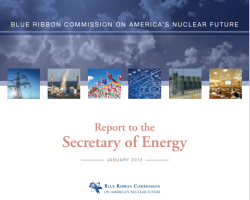Category of Content
Siting Experience Documents Only
Publication Date
Keywords
Letter to President Obama - Blue Ribbon Commission
Letter to President Obama - Blue Ribbon Commission
Dear Mr. President:
At your direction, the Secretary of Energy established the Blue Ribbon Commission on
America’s Nuclear Future to review policies for managing the back end of the nuclear
fuel cycle and recommend a new strategy. We are pleased to be serving as Co‐
Chairmen of the Commission, and we are writing to you to highlight an important action
we strongly believe should be reflected in your Fiscal Year 2013 baseline budget
projections.
In our draft report to the Secretary, issued in July of this year, the Commission
Recommendation by the Secretary of Energy of Candidate Sites for Site Characterization for the First Radioactive-Waste Repository
Recommendation by the Secretary of Energy of Candidate Sites for Site Characterization for the First Radioactive-Waste Repository
The Nuclear Waste Policy Act of 1982 (the Act), established a
step-by-step process for the siting of the nation's first repository for
high-level radioactive waste and spent fuel. The Act gave the Department of
Energy (DOE) the primary responsibility for conducting this siting process.
The first step in the process laid out in the Act was the development by
the DOE, with the concurrence of the Nuclear Regulatory Commission (NRC), of
general guidelines to be used by the Secretary of the DOE (the Secretary) in
Cost Estimate for an Away-From-Reactor Generic Interim Storage Facility (GISF) for Spent Nuclear Fuel
Cost Estimate for an Away-From-Reactor Generic Interim Storage Facility (GISF) for Spent Nuclear Fuel
As nuclear power plants began to run out of storage capacity in spent nuclear fuel (SNF) storage pools, many nuclear operating companies added higher density pool storage racks to increase pool capacity. Most nuclear power plant storage pools have been re-racked one or more times. As many spent fuel storage pools were re-racked to the maximum extent possible, nuclear operating companies began to employ interim dry storage technologies to store SNF in certified casks and canister-based systems outside of the storage pool in independent spent fuel storage installations (ISFSIs).
Technical Bases for Extended Dry Storage of Spent Nuclear Fuel
Technical Bases for Extended Dry Storage of Spent Nuclear Fuel
Independent spent fuel storage installations (ISFSIs) are currently licensed for 20 years. However, delays in developing permanent spent fuel disposal capability require continued ISFSI storage beyond the 20-year term. This report provides a technical basis for demonstrating the feasibility of extended spent fuel storage in ISFSIs.
Blue Ribbon Commission on America’s Nuclear Future Draft Report to the Secretary of Energy
Blue Ribbon Commission on America’s Nuclear Future Draft Report to the Secretary of Energy
America’s nuclear waste management program is at an impasse. The Obama Administration’s decision
to halt work on a repository at Yucca Mountain in Nevada is but the latest indicator of a policy that has
been troubled for decades and has now all but completely broken down. The approach laid out under
the 1987 Amendments to the Nuclear Waste Policy Act (NWPA)—which tied the entire U.S. high-level
waste management program to the fate of the Yucca Mountain site—has not worked to produce a
Blue Ribbon Commission on America’s Nuclear Future Report to the Secretary of Energy
Blue Ribbon Commission on America’s Nuclear Future Report to the Secretary of Energy
This report highlights the findings and conclusions of the Blue Ribbon Commission on America’s Nuclear Future (BRC) and presents recommendations for consideration by the Administration and Congress, as well as interested state, tribal and local governments, other stakeholders, and the public.
THERMAL PERFORMANCE SENSITIVITY STUDIES IN SUPPORT OF MATERIAL MODELING FOR EXTENDED STORAGE OF USED NUCLEAR FUEL
THERMAL PERFORMANCE SENSITIVITY STUDIES IN SUPPORT OF MATERIAL MODELING FOR EXTENDED STORAGE OF USED NUCLEAR FUEL
The work reported here is an investigation of the sensitivity of component temperatures in a specific storage system, including fuel cladding temperatures, in response to modeling assumptions that differ from design-basis, including age-related changes that could degrade the thermal behavior of the system. Preliminary evaluations of representative horizontal and vertical storage systems at design basis conditions provides general insight into the expected behavior of storage systems over extended periods of time.
DECOMMISSIONING COST ANALYSIS for the CLINTON POWER STATION
DECOMMISSIONING COST ANALYSIS for the CLINTON POWER STATION
<div class="page" title="Page 1">
<div class="section">
<div class="layoutArea">
<div class="column">
Crystal River Unit 3 -- UPDATED IRRADIATED FUEL MANAGEMENT PROGRAM- 10 CFR 50.54(bb) and SITE-SPECIFIC DECOMMISSIONING COST ESTIMATE FOR THE CRYSTAL RIVER UNIT 3 NUCLEAR GENERATING PLANT
Crystal River Unit 3 -- UPDATED IRRADIATED FUEL MANAGEMENT PROGRAM- 10 CFR 50.54(bb) and SITE-SPECIFIC DECOMMISSIONING COST ESTIMATE FOR THE CRYSTAL RIVER UNIT 3 NUCLEAR GENERATING PLANT
<div class="page" title="Page 2">
<div class="layoutArea">
<div class="column">
Kewaunee Power Station -- Post-Shutdown Decommissioning Activities Report
Kewaunee Power Station -- Post-Shutdown Decommissioning Activities Report
<div class="page" title="Page 8">
<div class="layoutArea">
<div class="column">

